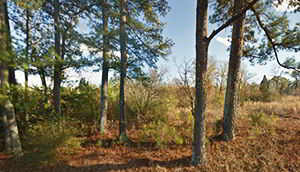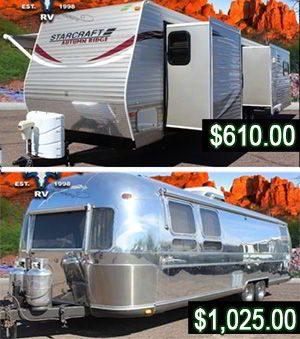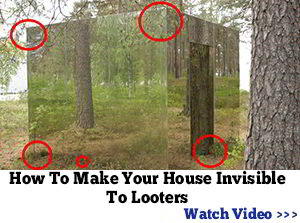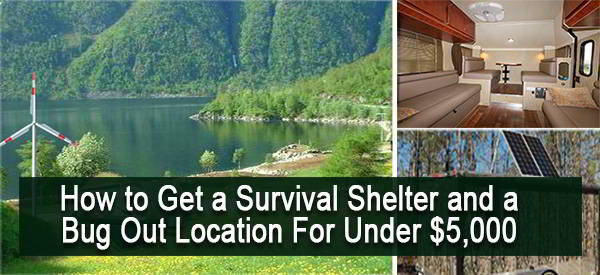I think just about everyone who’s been in the prepping movement for any time wishes they had a bug out survival shelter, off hidden in the woods somewhere. It doesn’t matter if you’re dreaming about a cabin in the woods or a bunker, the idea is the same. You want someplace safe you can take your family, in the event of a major disaster, where you can be fairly certain that you won’t be found.
The big problem for most of us is that we can’t afford $100,000, $50,000, or even $30,000 to pay for that survival shelter or cabin. So, we keep on wishing, while realizing that there’s really nothing that we can do.
What would you say, if I told you that you could have a cheap survival shelter outside of town for as little as $5,000? It may not be an underground bunker and it might not have the charm of a well-made log cabin in the woods, but it will be someplace that you and your family can go to, when the time comes to bug out. Not only that, but it will probably be pretty hard for anyone to find you.
I’m not talking about building a cabin out of all scavenged materials either. While that can be done, and has been done rather successfully by a number of people, the time investment is more than what most of us can afford. The time to build it is bad enough; the real problem is the time to scavenge the materials. That actually takes longer.
Related: How Much Does a Nuclear Bunker Cost?
Start with the Land
The starting point has always got to be some land. If you don’t have any place to put your survival shelter, then you’re not going to have one. So, we’ve got to come up with some land somewhere, which can be used for building the survival shelter. Not only that, but we need it to be affordable.
Before actually looking for any land, take a moment to think about who you know that owns some land outside of town. Perhaps you have a friend or family member who has a few acres outside of town someplace. If you do, then you might have an ideal place to set up your survival shelter, if they are willing to allow you to do so on their property.
The second possibility to consider is buying land in conjunction with your survival group or team, assuming that you are part of one. Splitting the cost of a few acres of land with your team could be the way to keep the price down. There is a lot of land around, which can be picked up for $5,000 to $10,000 dollars per acre. Split between five families, that’s some pretty cheap land.

The third possibility is to buy what is known as junk land.
Now, before I go any farther with this, let me warn you; you have to be careful buying junk land. The land is junk because it doesn’t have any viable use. It can’t be used agriculturally and it’s not near enough to any population centers to make it viable land for building homes, businesses or factories on it. Because of this, it doesn’t have any utilities on it. But the biggest problem with junk land is the lack of water. You’re going to have to find some way of getting water onto your land.
Nevertheless, we’re talking survival here. So, that junk land may just be the thing you need, especially if you can find junk land that is close enough to a source of water for you to haul water to the land. The trick is finding it or producing it.
Related: H2O Dynamo – The Awesome Device That Turns Air Into Water (Video)
There are a few websites that offer junk land for sale. Typically, you’ll find one of two problems with these. One is that they are commercial sites which just sell junk land. In most cases, the land they are selling is not well defined, described or surveyed. They’re selling tracts of land that don’t have any access and where there is no space left between the lots for roadways. So, while it is a nice, private location perfect for building a cheap survival shelter, access may be a problem.
The other problem is that many times these websites say they are selling junk land, but when you look at it, you find that the land is $20,000 per acre. So, you’re going to need patience in looking for your spot.
Your best bet will probably be to advertise for junk land in the area you want to buy it. Put a want ad in the paper, saying that you’re looking for an acre or two of junk land. Then wait for the phone calls. You’ll get a bunch from real estate agents who want to sell you something other than what you want; but you might actually get a call from someone who has exactly what you need.
When looking at junk land, be sure to check for:
- Legal access – There may not be a road. If there isn’t, make sure that your purchase contract includes right of way to your land and that the seller really can give you that access. To me, lack of an access road isn’t a big deal, as long as there is some sort of access I can get my truck across. The lack of a road will make it harder for others to find me too.
- Access to water – While I can pretty much guarantee you that there won’t be any water on your land, you will need water. So, either the ground water needs to be high enough that you can drill for it, there must be enough rainfall that you can use rainwater catchment (that’s not legal in all states) or there is somewhere nearby that you can get water from and haul it to your land. Another option would be to build a water generator, but you’ll need to have at least two solar panels as well.
- Clearly defined boundaries – Some people who are selling junk land are not bothering to survey it and mark clear boundaries. Without that, you won’t have any idea of what land is yours.
Related: Do You Make These 5 Home-defense Mistakes in a Crisis? (Video)
Even with these requirements, you should be able to find junk land for $500 to $1,000 per acre. While it won’t be the most beautiful land you’ve ever seen, it will be land that you can use for a survival retreat and will be remote enough that you shouldn’t be bothered there.
For A Cheap Survival Shelter
The easiest way to put shelter on your land is to buy a used travel trailer. New trailers are rather expensive and even newer used ones can have some steep price. But when you start looking at trailers that are 15 years old or more, the price drops quite a bit. I’ve looked on eBay and seen trailers in fairly good shape that were going for $800 to $3,000.

You’ll probably have to do some repairs on the trailer, but that’s okay. Remember, you’re trying to come up with a survival shelter and bug out retreat, not a luxury vacation home. If you could afford a luxury vacation home, you wouldn’t be buying a used trailer.
I lived for nine years in an old Winnebago motorhome. While it had plenty of problems, I found it to work out well as a home, even considering that we had too much stuff in it and we overused it extensively. The convenience of having all the furniture built-in gives you a very efficient living space; and provides enough bunking space for a family.
The one thing you’ll find that your travel trailer won’t have is enough storage space. If you’re planning on using this as a cheap survival retreat, you’re going to want to add to the available storage. That could be added inside the trailer or outside, depending on your particular needs.
I would not recommend leaving a lot of supplies in your trailer, unless you have a secure storage container parked beside it. But that could put you over what you can afford to spend on your survival shelter and retreat. So instead, I would plan on hauling your supplies to the shelter when you bug out. The one thing I would plan on leaving on site would be a large supply of water, stocked in tanks or barrels, so that it will be there waiting for you when you arrive. Bury it or camouflage it so that it doesn’t attract attention.
Providing Yourself with Utilities
The travel trailer will have some utilities available in it. Typically, they have a propane tank to run heating, cooking and the refrigerator. The refrigerator is usually dual-fuel, running off of either propane or electricity. There will also be a water tank and sewage tank onboard. However, their capacity will be limited. Some electrical power will be supplied by a battery, mostly for lighting and pumps. However, travel trailers rarely have generators or other means to recharge those batteries.
Related: 10 Things to Have Ready Before The Huge EMP
The first and most important thing you’ll need is a source for water. If possible, the best thing to do is to put in a well. Unless you are in a very arid area or one with a lot of clay in the soil, you can put in a driven well, which is literally pounded into the ground, like a long spike.
A driven well consists of a well point, which is a steel pipe with a point attached. The sides of the pipe have been cut and screening installed, so that the first section of pipe can act as the well screen too. A cap is placed on this pipe and it is pounded into the ground with a sledge hammer or fence post driver, until it is almost flush with the ground. Then the cap is removed, a coupler put on and another section of pipe added. This process is continued until you reach a water-bearing sand layer, hopefully within about 20 to 25 feet.
If you have to go deeper than this, you’ll have to drill a well, which requires more elaborate equipment. Well drills can be rented in some parts of the country, but other parts don’t allow drilling without a license.
If you can’t get ground water, your other options are rainwater catchment and hauling water in. You have to have water, so that’s the first thing you should work on. And of course a water filter. Click on the link to learn how to build the 3 bucket water filter. You’ll also need some sort of way to get rid of waste water, so you’ll need to run some drain pipe to a pit in the ground.
Your next concern is electrical power. While you can get by with very little electrical power, you will need to be able to run the pumps, refrigerator and lights in the trailer, so you will need some. A couple of solar panels on the roof will usually take care of this need. Click on the link to learn how to build your own, cheap solar panels. For best results, don’t mount the panels flat, but rather angle them so that they are facing the sun.
If you want more electrical power than a couple of solar panels can provide, your best bet is going to be to build a homemade wind generator. While you can buy these commercially from any of the home improvement centers, building your own wind turbine is actually rather easy. All you need is a DC motor to use for the generator itself. Then you build a hub and attach some blades. One or two weekends will see your wind turbine up and running, providing you with the electricity you need.
The key to building a homemade wind turbine is the DC motor. You need a relatively low speed one, designed to run at 200 to 400 RPM, consuming 24 to 36 volts. This will ensure that it will produce at least 12 volts of power, when it is used as a wind turbine.
Related: 5 Best Countries To Move To Before SHTF
As long as you have enough wind to operate it, wind turbines are actually much more efficient than solar panels. One wind turbine with three, 30 inch to three foot blades will produce as much power as six to eight solar panels, assuming you have a good motor to start with. Blade shape is not highly critical, as long as the blades are angled in such a way that the pushing wind will cause them to turn. Splitting a 6″ diameter PVC plumbing pipe will provide such blades.
The one other thing you’ll need to complete your “utilities” is an additional propane tank. The on-board tank or tanks will probably supply you with enough propane to last a few months. Buying an additional 100 pound tank and an adapter hose to attach it in place of the on-board tanks will ensure that you can go several more months, before you have to be looking for propane.
Conclusion
So, there you have it. Assuming that you’re able to buy your land and travel trailer right, you should still have a thousand dollars to take care of your utilities with. That will make the whole project fall within the $5,000 price tag that I mentioned at the beginning.
Granted, this isn’t going to be the Ritz, but it will make for a fairly comfortable, but cheap, survival shelter. That’s what you need, more than anything else. Additional storage, water tanks and electricity could make it even nicer, if you end up having the time and money to work with, once you have the basic survival shelter up and running. If a disaster never comes, you’ll have a good place to get away from it all on the weekends.
You may also like:
 How Long Can You Store Water Before It Becomes Unsafe To Drink?
How Long Can You Store Water Before It Becomes Unsafe To Drink?
How To Build An Underground Bunker For Only $400 (Video)
















When buying land, consider location to any nuclear facilities and also look at who owns mineral rights to that land.
I had a small camper set up in a remote area for a hunting camp with two small propane tanks and basic supplies. After arriving one year, I found the propane tanks missing along with most of my supplies. When the ground thawed, I dug a pit 3′ wide, 6′ long, and 2′ deep, large enough to hold a couple of plastic containers for supplies and 2 propane tanks. I covered this pit with a sheet of marine plywood. I coated the surface of the plywood with construction adhesive and covered that with grass, twigs, and pebbles which stuck nicely to the adhesive. Before leaving camp for the season, I stored everything in the pit, covered it, and backed the camper over the pit. As far as I could tell, no one noticed the pit and if they had, they couldn’t get into it without moving the camper which had a hitch lock to prevent anyone from stealing it. This worked well for quite a few years until I sold the property.
You’re kidding! Those two trailers are not going to be available EVER for the prices you’ve shown. Hey, be realist. For the money you are talking about spending, you are going to get a piece of junk
WOW, you guys have it good over there. In Australia even what you call junk land would set you back a minimum of $200,000. Land is horrendously expensive and if you could get land for less than $1000/acre it would be in the middle of the outback more than 10 hours drive from the cities and no chance of water or even rain most of the year. At least they haven’t made rainwater collection illegal yet but some areas do have to pay fees for it. Even a dodgy old caravan without windows will cost you $500. Anything actually usable will be several thousand at least. The cheapest old shipping containers are at least $2000 and to get it anywhere outside a capital city will cost thousands in transport. The only good thing is that in Australia people don’t seem to resort to looting and pillaging at the first sign of trouble (most couldn’t be bothered I guess) so bugging in is still a viable option for most people
I realize that this exceptionally great article was written 7 years ago. It is Now May 2022 and what has been foreseen is now becoming a reality in real world time. I have been looking for land with these requirements: Water, treed, decent climate, and right up there with water, is affordability. I am 67 and living on slightly over $900 a month. But have managed to save a VERY small amount of cash. I do have a small fifth wheel.. not the best thing to haul around, but once parked, it’ll be fine. My old truck will need to haul it first, and then I will need to move my preps to it, just because of weight. Do you have any land suggestions? I live in Washington, do not want to be here, but seems that only affordable land without being surrounded by nuclear plants.. are states either currently in or soon to be in a drought, or have never had water to begin with. I LOVE Idaho, but it has pretty much been bought out by Californians and is now ridiculously expensive and well on its way to overpopulation. So? Maybe time to write an article for low fixed income senior preppers? We have the preps, we are not afraid of physical labor and have common sense, we just have nowhere to go.
Thank you for your time. Not sure if you will even see this. Take Care and Good Luck to All Of Us.